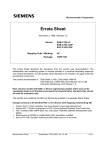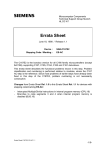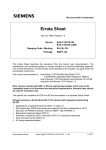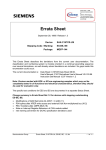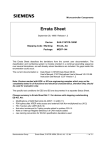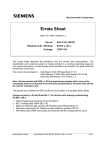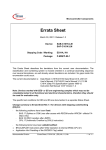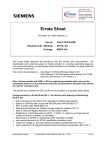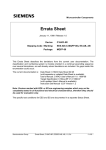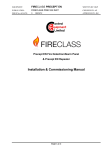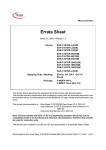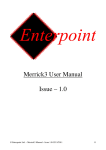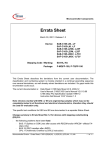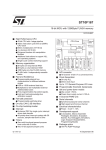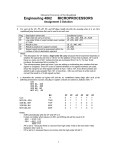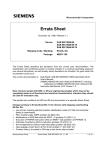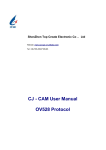Download Errata Sheet
Transcript
Microcontroller Components Errata Sheet October 2, 1998 / Release 1.1 Device: Stepping Code / Marking: Package: SAB-C161V-L16M AA MQFP-80 This Errata Sheet describes the deviations from the current user documentation. The classification and numbering system is module oriented in a continual ascending sequence over several derivatives, as well already solved deviations are included. So gaps inside this enumeration could occur. The current documentation is: Data Sheet: C161V/C161K/C161O Data Sheet 03.97, User’s Manual: C161V/C161K/C161O User’s Manual 12.96, Version 1.0 Instruction Set Manual 12.97 Version 1.2 Note: Devices marked with EES- or ES are engineering samples which may not be completely tested in all functional and electrical characteristics, therefore they should be used for evaluation only. The specific test conditions for EES and ES are documented in a separate Status Sheet. Change summary to Errata Sheet Rel.1.0 for devices with stepping code/marking AA: • • • • • • • PEC Transfers after JMPR (BUS.18) Arithmetic Overflow by DIVLU instruction (CPU.17) System Configuration via P0L.0 during Software/Watchdog Timer Reset (RST.1) new naming convention for DC/AC specification deviations used Limit for timing t6 (address setup to ALE) changed from TCL-15 to TCL-17.5ns (AC.t6.1) Limit for timing t22 (data valid to WR#) changed from 2TCL-15 to 2TCL-20ns (AC.t22.1) Note about Address Window Arbitration added (see end of document) Semiconductor Group Errata Sheet, C161V-L16M, AA, 1.1, Mh - 1 of 8 - Functional Problems: CPU.17: Arithmetic Overflow by DIVLU instruction For specific combinations of the values of the dividend (MDH, MDL) and divisor (Rn), the Overflow (V) flag in the PSW may not be set for unsigned divide operations, although an overflow occurred. E.g.: MDH F0F0 MDL Rn MDH MDL 0F0Fh : F0F0h = FFFF FFFFh, but no Overflow indicated! (result with 32-bit precision: 1 0000h) The same malfunction appears for the following combinations: n0n0 0n0n : n0n0 n00n 0nn0 : n00n n000 000n : n000 n0nn 0nnn : n0nn where n means any Hex Digit between 8 ... F i.e. all operand combinations where at least the most significant bit of the dividend (MDH) and the divisor (Rn) is set. In the cases where an overflow occurred after DIVLU, but the V flag is not set, the result in MDL is equal to FFFFh. Workaround: Skip execution of DIVLU in case an overflow would occur, and explicitly set V = 1. E.g.: CMP Rn, MDH JMPR cc_ugt, NoOverflow ; no overflow if Rn > MDH BSET V ; set V = 1 if overflow would occur JMPR cc_uc, NoDivide ; and skip DIVLU NoOverflow: DIVLU Rn NoDivide: ... ; next instruction, may evaluate correct V flag Note: - the KEIL C compiler, run time libraries and operating system RTX166 do not generate or use instruction sequences where the V flag in the PSW is tested after a DIVLU instruction. - with the TASKING C166 compiler, for the following intrinsic functions code is generated which uses the overflow flag for minimizing or maximizing the function result after a division with a DIVLU: _div_u32u16_u16() _div_s32u16_s16() _div_s32u16_s32() Consequently, an incorrect overflow flag (when clear instead of set) might affect the result of one of the above intrinsic functions but only in a situation where no correct result could be calculated anyway. These intrinsics first appeared in version 5.1r1 of the toolchain. Libraries: not affected Semiconductor Group Errata Sheet, C161V-L16M, AA, 1.1, Mh - 2 of 8 - CPU.11: Stack Underflow Trap during Restart of interrupted Multiply Wrong multiply results may be generated when a STUTRAP (stack underflow) is caused by the last implicit stack access (= pop PSW) of a RETI instruction which restarts an interrupted MUL/MULU instruction. No problem will occur in systems where the stack overflow/underflow detection is not used, or where an overflow/underflow will result in a system reset. Workaround 1: Avoid a stack overflow/underflow e.g. by - allocating a larger internal system stack (via bitfield STKSZ in register SYSCON), or - reducing the required stack space by reducing the number of interrupt levels, or - testing in each task procedure whether a stack underflow is imminent, and anticipating the stack refill procedure before executing the RETI instruction. Workaround 2: Disable MULx instructions from being interrupted e.g. with the following instruction sequence: ATOMIC #1 MULx Rm, Rn Workaround 3 (may be selected if no divide operations are used in an interruptible program section): In each interrupt service routine (task procedure), always clear bit MULIP in the PSW and set register MDC to 0000h. This will cause an interrupted multiplication to be completely restarted from the first cycle after return to the priority level on which it was interrupted. In case that an interrupt service routine is also using multiplication, only registers MDH and MDL must be saved/restored when using this workaround, while bit MULIP and register MDC must be set to zero. CPU.9: PEC Transfers during instruction execution from Internal RAM When a PEC transfer occurs after a jump with cache hit during instruction execution from internal RAM (locations 0FA00h - 0FDFFh), the instruction following the jump target instruction may not be (correctly) executed. This problem occurs when the following sequence of conditions is true: i) a loop terminated with a jump which can load the jump target cache (possible for JMPR, JMPA, JB, JNB, JBC, JNBS) is executed in the internal RAM ii) at least two loop iterations are performed, and no JMPS, CALLS, RETS, TRAP, RETI instruction or interrupt is processed between the last and the current iteration through the loop (i.e. the condition for a jump cache hit is true) iii) a PEC transfer is performed after the jump at the end of the loop has been executed iv) the jump target instruction is a double word instruction Workaround 1: Place a single word instruction (e.g. NOP) at the jump target address in the internal RAM. Workaround 2: Use JMPS (unconditional) or JMPI (conditional) instructions at the end of the loop in the internal RAM. These instructions will not use the jump cache. Semiconductor Group Errata Sheet, C161V-L16M, AA, 1.1, Mh - 3 of 8 - CPU.8: Jump instructions in EXTEND sequence When a jump or call is taken in an EXTS, EXTSR, EXTP, or EXTPR sequence, a following data access included in the EXTEND sequence might be performed to a wrong segment or page number. Note: ATOMIC or EXTR sequences are not affected by this problem. Example: Accessing double-word data with a check on segment overflow between the two accesses (R5 contains 8-bit segment number, R4 contains 16-bit intra-segment offset address): EXTS R5,#4 ; start EXTEND sequence MOV R10,[R4+] ; get first word CMP R4,#0 ; check for segment overflow JMPR cc_NZ,Next ; jump if no segment overflow ADD R5,#1 ; increment to next segment EXTS R5,#1 ; continue EXTEND sequence Next: MOV R11,[R4] ; get second word With this sequence, the problem can occur when the jump is taken to label Next; the data access here might use a wrong segment number. Workaround: Do not use jumps or calls in EXTS, EXTSR, EXTP, or EXTPR sequences. This can be done very easily since only an actual data access must be included in an EXTEND sequence. All other instructions, such as comparisons and jumps, do not necessarily have to be in the EXTEND sequence. For the example shown above, there are several possibilities to get around the problem: a) with a jump, but EXTEND sequence only for the data accesses Next: EXTS MOV CMP JMPR ADD EXTS MOV R5,#1 R10,[R4+] R4,#0 cc_NZ,Next R5,#1 R5,#1 R11,[R4] ; EXTEND sequence only for data access ; get first word ; check for segment overflow ; jump if no segment overflow ; increment to next segment ; second EXTEND sequence for data access ; get second word b) without a jump EXTS MOV ADD ADDC EXTS MOV R5,#4 R10,[R4] R4,#2 R5,#0 R5,#1 R11,[R4] ; EXTEND sequence ; get first word ; increment pointer here ; add possible overflow from pointer inc. ; continue EXTEND sequence ; get second word The first EXTEND instruction of example b) can also be modified such that only the following data access is included in the EXTEND sequence (EXTS R5,#1). This additionally has the effect of a reduced interrupt latency. Notes on Compilers and Operating Systems Such critical sequences might be produced within library functions of C-Compilers when accessing huge double-word data, or in operating systems. From the following compiler versions, we currently know that they are not affected by this problem: BSO/Tasking V4.0r3 HighTec C16x-GNU-C V3.1 Keil C166 (from V2.60) Semiconductor Group Errata Sheet, C161V-L16M, AA, 1.1, Mh - 4 of 8 - CPU.7: Warm HW Reset (Pulse Length < 1032 TCL) In case a HW reset signal with a length < 1032 TCL (25.8 µs @ 20 MHz) is applied to pin RSTIN#, the internal reset sequence may be terminated before the specified time of 1032 TCL, and not all SFRs and ESFRs may be correctly reset to their default state. Instead, they maintain the state which they had before the falling edge of RSTIN#. The problem occurs when the falling edge of the (asynchronous) external RSTIN# signal is coincident with a specific internal state of the controller. The problem will statistically occur more frequently when waitstates are used on the external bus. Workaround: Extend the HW reset signal at pin RSTIN# (e.g. with an external capacitor) such that it stays below V IL (0.2 Vcc - 0.1 V) for at least 1032 TCL. BUS.18: PEC Transfers after JMPR instruction Problems may occur when a PEC transfer immediately follows a taken JMPR instruction when the following sequence of 4 conditions is met (labels refer to following examples): 1. in an instruction sequence which represents a loop, a jump instruction (Label_B) which is capable of loading the jump cache (JMPR, JMPA, JB/JNB/JBC/JNBS) is taken 2. the target of this jump instruction directly is a JMPR instruction (Label_C) which is also taken and whose target is at address A (Label_A) 3. a PEC transfer occurs immediately after this JMPR instruction (Label_C) 4. in the following program flow, the JMPR instruction (Label_C) is taken a second time, and no other JMPR, JMPA, JB/JNB/JBC/JNBS or instruction which has branched to a different code segment (JMPS/CALLS) or interrupt has been processed in the meantime (i.e. the condition for a jump cache hit for the JMPR instruction (Label_C) is true) In this case, when the JMPR instruction (Label_C) is taken for the second time (as described in condition 4 above), and the 2 words stored in the jump cache (word address A and A+2) have been processed, the word at address A+2 is erroneously fetched and executed instead of the word at address A+4. Note: the problem does not occur when the jump instruction (Label_C) is a JMPA instruction Example1: Label_A: instruction x ; Begin of Loop instruction x+1 ..... Label_B: JMP Label_C ; JMP may be any of the following jump instructions: JMPR cc_zz, JMPA cc_zz, JB/JNB/JBC/JNBS ; jump must be taken in loop iteration n ; jump must not be taken in loop iteration n+1 ..... Label_C: JMPR cc_xx, Label_A ; End of Loop ; instruction must be JMPR (single word instruction) ; jump must be taken in loop iteration n and n+1 ; PEC transfer must occur in loop iteration n Semiconductor Group Errata Sheet, C161V-L16M, AA, 1.1, Mh - 5 of 8 - Example2: Label_A: instruction x ; Begin of Loop1 instruction x+1 ..... Label_C: JMPR cc_xx, Label_A ; End of Loop1, Begin of Loop2 ; instruction must be JMPR (single word instruction) ; jump not taken in loop iteration n-1, i.e. Loop2 is entered ; jump must be taken in loop iteration n and n+1 ; PEC transfer must occur in loop iteration n ..... Label_B: JMP Label_C ; End of Loop2 ; JMP may be any of the following jump instructions: JMPR cc_zz, JMPA cc_zz, JB/JNB/JBC/JNBS ; jump taken in loop iteration n-1 A code sequence with the basic structure of Example1 was generated e.g. by a compiler for comparison of double words (long variables). Workarounds: 1. use a JMPA instruction instead of a JMPR instruction when this instruction can be the direct target of a preceding JMPR, JMPA, JB/JNB/JBC/JNBS instruction, or 2. insert another instruction (e.g. NOP) as branch target when a JMPR instruction would be the direct target of a preceding JMPR, JMPA, JB/JNB/JBC/JNBS instruction, or 3. change the loop structure such that instead of jumping from Label_B to Label_C and then to Label_A, the jump from Label_B directly goes to Label_A. Notes on compilers: In the Hightec compiler beginning with version Gcc 2.7.2.1 for SAB C16x – V3.1 Rel. 1.1, patchlevel 5, a switch –m bus18 is implemented as workaround for this problem. In addition, optimization has to be set at least to level 1 with –u1. The Keil C compiler and run time libraries do not generate or use instruction sequences where a JMPR instruction can be the target of another jump instruction, i.e. the conditions for this problem do not occur. Other compilers under evaluation. RST.1: System Configuration via P0L.0 during Software/Watchdog Timer Reset Unlike P0L.5 .. P0L.1, P0L.0 is not disregarded during software or watchdog timer reset. This means that when P0L.0 is (erroneously) externally pulled low at the end of the internal software or watchdog timer reset sequence, the device will enter emulation mode. Therefore, ensure that the level at P0L.0 is above the minimum input high voltage VIHmin= 0.2 Vcc + 0.9 V (1.9 V @ Vcc = 5.0 V) at the end of the internal reset sequence. Semiconductor Group Errata Sheet, C161V-L16M, AA, 1.1, Mh - 6 of 8 - Deviations from Electrical- and Timing Specification: The following table lists the deviations of the DC/AC characteristics from the specification in the C161V/C161K/C161O Data Sheet 03.97 3UREOHP 3DUDPHWHU 6\PERO /LPLW 9DOXHV VKRUW QDPH DC.RRST.1 RSTIN# pull-up Problem Parameter short name RRST Symbol 8QLW min. max. 25 instead of 50 125 instead of 150 Max. CPU Clock = 16 MHz 7HVW &RQGLWLRQ kΩ Variable CPU Clock Unit 1/2TCL = 1 to 16 MHz min. max. min. AC.t6.1 Address setup to ALE t6 13.5+ta instead of 16+ta - TCL-17.5+ta instead of TCL-15+ta max. ns AC.t22.1 Data valid to WR# t22 43+tc instead of 48+tc - 2TCL-20+tc instead of 2TCL-15+tc ns - Notes: 1) Timing t28: Parameter description and test changed from ’Address hold after RD#/WR#’ to ’Address hold after WR#’. It is guaranteed by design that read data are internally latched by the controller before the address changes. 2) During reset, the port 6 lines P6.[3:0] are pulled high by internal pull-ups. Semiconductor Group Errata Sheet, C161V-L16M, AA, 1.1, Mh - 7 of 8 - History List (since device step AA) Functional Problems Functional Short Description Problem Fixed in step CPU.7 Warm hardware reset (pulse length < 1032 TCL) CPU.8 Jump instructions in EXTEND sequence CPU.9 PEC Transfers during instruction execution from Internal RAM CPU.11 Stack Underflow Trap during restart of interrupted Multiplication CPU.17 Arithmetic Overflow by DIVLU instruction BUS.18 PEC transfers after JMPR RST.1 System Configuration via P0L.0 during Software/Watchdog Timer Reset AC/DC Deviations AC/DC Deviation Short Description Fixed in step DC.RRST.1 RSTIN pull-up 25 to 125 kΩ AC.t22.1 Data valid to WR# 2TCL-20ns Note The Address Window Arbitration feature as described in the C161V/C161K/C161O User’s Manual V1.0, p.8-21 is not yet implemented in C161V/C161K/C161O devices with stepping code/marking AA. For these devices, the address windows defined by ADDRSEL1 through ADDRSEL4 must not overlap each other. Application Support Group, Munich Semiconductor Group Errata Sheet, C161V-L16M, AA, 1.1, Mh - 8 of 8 -








